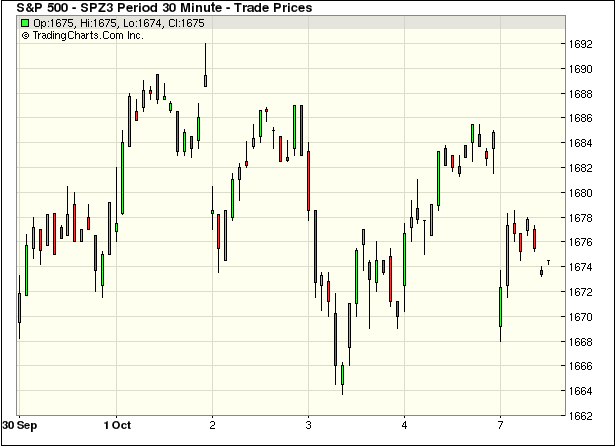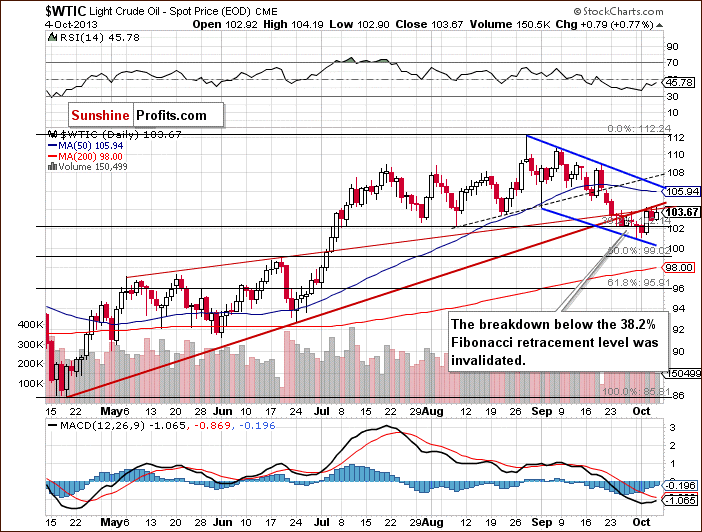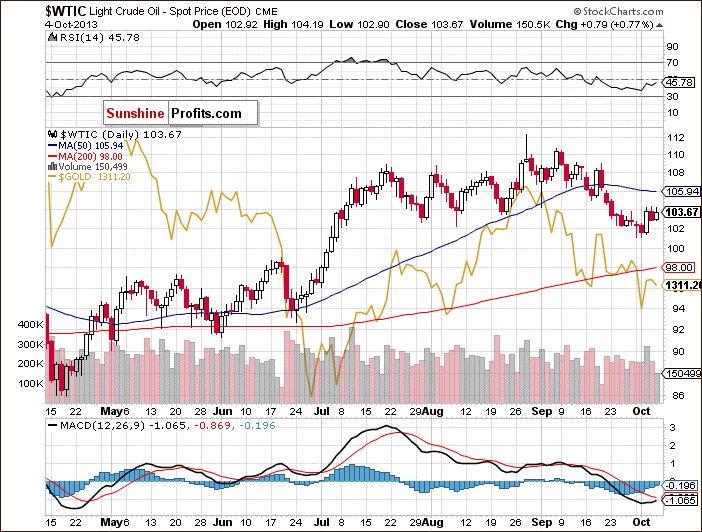Money Talks Michael Campbell interviews Josef Schachter, Canada’s leading independent energy analyst and founder of Schachter Asset Management
Michael Campbell: How has the budget and debt ceiling debate going on in the United States affect energy prices the oil market in particular?
Schachter: The problem with the US’s is it’s pretty anemic growth of about 1.5 -2 % of real GDP, and every week that the US economy has the government shutdown its near a 1/4 of 1% for for the week impacting the quarterly numbers. So if the Government is shut down for 2 or 3 weeks you’ve got barely much growth in the US. Of course if the economy is not growing in the states the demand for energy is going to be weak.
For example if you look at last week’s data be demand fell from 19.3 million barrels per day to 18.7, down 580,000 barrels a day. So now you’ve now got supply in the US, with inventories built by 5 million barrels of crude oil last week and you have 97.5 days of supply which is probably 10 or 12 days more than is necessary.
You’ve also got increasing production in the United States as well as OPEC increasing production. Specifically you’ve got Nigeria, Saudi and Iraq increasing production, plus if there’s a resolution of this Iran situation, and all of a sudden Iran’s sanctions are removed, they’re going to increase production and all of a sudden you’re going to have a glut on the world.
In short from a from a fundamental point of view we’ve been bearish on energy. We’ve said the fair value of the price of oil is $70-$80 and that there has been about a $30 risk premium in it because of the problems in Syria, Iran and Egypt. So you have maybe $10 dollars for each of those items and slowly each them seem to be resolving. All of a sudden that risk premium should come out.
Since we’ve been cautious on energy the index may be up 3 or 4 %, but it has been very difficult to make money in the sector. Now with oil potentially vulnerable to the downside here you want to be very careful or be underweight the sector.
 Campbell:
Campbell: One of the things that comes out of the blue are solutions to things that we didn’t see coming. For example in the early 1980’s we had the National Energy Policy projecting huge jumps in the price of oil that didn’t manifest because they couldn’t anticipate fuel injection being so much more efficient than carburetors.
The equivalent today, perhaps even more profound is incredible impact of Fracking on keeping
natural gas prices low and oil supply increasing. Is Canada about to miss their opportunity because of the negativity towards the energy sector?
Schachter: Yes, Take for example the province to BC having these issues about LNG in the export terminals, you know the longer they take to get a resolution and get a go-ahead other countries like Australia and other places are going take that market share away. The longer the political and environmental hurdles take to resolve themselves as well as the fiscal arrangements where the government wants its share of the pie, all that has to be resolved in 2013. If it drags them through the end of 2014 others are going to take that market share that’s being created in Asia because Japan is closing the nuclear plant, as well as the existing demand in Korea and China. Add to that all these guys have the potential for shale, especially China, so there will probably be growing production growing on that side and they will want less from imports. Of course we will suffer.
I don’t think the total demand is going to be as vibrant that everybody’s talked about in the past because of technological advances. Right now the demand for crude oil maybe 90 million barrels worldwide. In the old days we used to say by the end of this decade it might be a 100 million. If we take into account the amount that’s going to come from non-OPEC, OPEC is going to lose market share and of course they’re not going to want to do that.
Campbell: One of things it’s killed me Joseph is the debate about the Northern Gateway pipeline has largely taken place outside at the reality of our demand for petroleum products. People still want to drive their cars and for all the incredible information, call it propaganda, they have not been able to make a go of it in the electric car market. Of course even in that market it depends how you’re producing electricity, if its in a coal-fired State it’s a joke if you think that’s an environmental savings.
We use jet fuel, heating oil, and gasoline and all that is transported by pipeline into BC.
Schachter: If they don’t go the pipeline route because of environmental blockages you are going to end up having rail cars going to the refineries that are willing to pay for it, because going by tank cars is way more expensive. Of course the tank cars go back empty so there are those inefficiencies as well.
The issue is safety and though some of the pipelines were built in the 50’s and 60’s the newest pipelines are being built with fabulous environmental standards. Simply put people are not being rational on pipeline opposition and in the end it is going to hurt Canada and our our fiscal position.
Campbell: US self-sufficiency in oil, is it a game-changer?
Schachter: Yes, as I mentioned earlier the US is producing about 7.8 million barrels of liquids, thats up 25.4 % from a year ago. So the total in the US is now 12.3 million barrels and consumption is only 18.7. Well the difference of about 6.3, Canada produces about a third of that then you have Mexico and Venezuela. So the need for all oil from the Middle East is really coming down. To be specific the US is now producing about 12.3 million barrels of liquids, 7.8 million of crude oil and natural gas liquids and renewables of 4.6 million, and they’re probably going to see growth of another million barrels in 2014. So as time goes on between fuel efficiency of individual cars and the greater use of natural gas the US which was using 21.8 million barrels a day is now down to 18.7. If that continues on a worldwide basis where fuel efficiency and new alternatives like using compressed natural gas, the demand is not going to be there for OPEC. Of course opec needs revenues to fund their their subsidized food programs they’re going to have to push out more product and and the price will come down.
I also think there’s gonna be some severe tax loss pressure this year as people made money in banks, insurance and in other areas but lost money in the mining and the energy sector, so we think there is going to be a significant amount of tax loss pressure on resource sectors in the November-December window. That probably will give us a nice buying opportunity and then there will be a nice bounce into 2014.
So my recommendation to find the names that you like and be ready to be buyers of those names during the upcoming tax selling pressure which will happen.
Campbell: If I was to make my list, what characteristics should these companies display?
Schacter: You want to have companies who have low cost a lot of upside in terms of the drill bit. Look for companies that have low finding cost, low operating costs, strong balance sheets and have land plays where there is significant upside.
Right it’s not easy to make much money in natural gas so everybody’s been moving towards liquids, but at some point we’re going to see natural gas be a much better commodity. Right now many companies are trading below Net Asset Value, so from an accounting point of view they are really cheap.
I think there is going to be another lengthy bull market cycle like we had from 1974 – 1981 or 1998 – 2008. It might start 2-3 years from now, in the meantime during the next couple of years you have to be a more nimble investor with a trading mentality because stocks swing around quite a bit with the commodity prices.
The names I like on the domestic side are companies like Delphi Energy Corp (DEE.TO), Long Run Exploration Ltd. ( LRE.TO) and Tamarack Valley Energy Ltd. ( TVE.V). All of them are up for the year because the liquids have done well. They’ve also done much better than the sector, Long Run up 25-30%, maybe more than that for Tamarack.
On the international side we like companies with drill bit upside, names like Petromanas Energy Inc. (PMI.V), WesternZagros Resources (WZR.V) and Dualex Energy Intl Inc. (DXE.V) that are exploration plays and if Mother Nature cooperates they could do very well. The sector on the international side has been pretty tough this year as as many you have your listeners would know
Campbell: Joseph, you’ve been giving good advice, at the last World Outlook Conference you made a very clear that there were better places to put your money in and you were certainly dead on about that. Thank you for joining us today.
 Our Quick Pivot of August 22nd noted that the surge in Precious Metals had become speculative. The RSI on the silver/gold ratio had reached 79 when anything above 78 indicated “dangerous conditions”.
Our Quick Pivot of August 22nd noted that the surge in Precious Metals had become speculative. The RSI on the silver/gold ratio had reached 79 when anything above 78 indicated “dangerous conditions”.
 So, for all the “fuss and turmoil” the markets really paid very little attention to the antics in Washington.
So, for all the “fuss and turmoil” the markets really paid very little attention to the antics in Washington.



 Campbell: One of the things that comes out of the blue are solutions to things that we didn’t see coming. For example in the early 1980’s we had the National Energy Policy projecting huge jumps in the price of oil that didn’t manifest because they couldn’t anticipate fuel injection being so much more efficient than carburetors.
Campbell: One of the things that comes out of the blue are solutions to things that we didn’t see coming. For example in the early 1980’s we had the National Energy Policy projecting huge jumps in the price of oil that didn’t manifest because they couldn’t anticipate fuel injection being so much more efficient than carburetors. 













